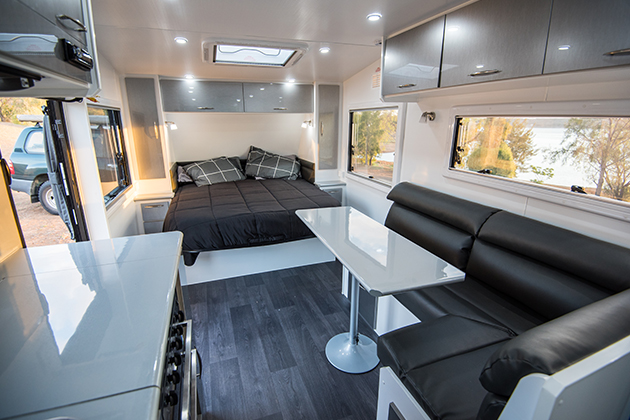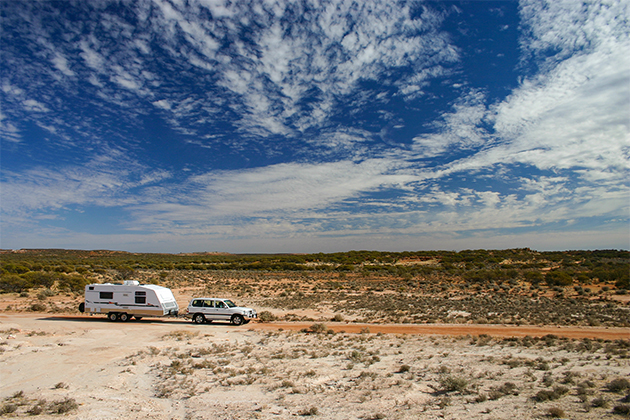Travel & Touring | Camping & Caravanning
1. Exceeding towing weight limits
Before hitching anything to the back of your tow vehicle, you'll need to know exactly what weight it's capable of towing.
The fine for towing a load over the vehicle's towing limit varies according to how far the limit has been exceeded. Your vehicle owners’ manual will have information about your specific towing capacity.
If your trailer has its own braking system, you'll need to know your vehicle's Maximum Braked Towing Limit. This is the upper limit of what your vehicle can tow. If you’re trailer does not have brakes, you’ll need to know the Maximum Unbraked Towing Limit of your vehicle which is how much the unbraked trailer, including its load, can weigh. Typically ths limit is 750kg, but many smaller vehicles are more limited in what they can tow – some as little as 350kg.
Calculating towing weights is a complex topic. You can find more details on our Caravan Towing Weights guide.
If your new caravan or trailer will be heavier than the towing capacity of your vehicle, you may need a different vehicle to do the job. Depending on how low your towing capacity is you could also consider a GVM (Gross Vehicle Mass) or GCM (Gross Combination Mass) upgrade on the vehicle. Just ensure the modifications are legally certified by the workshop carrying them out. Making sure your caravan or trailer is a safe match for your vehicle in the first place is the best option.
2. Following distance and parking restrictions
If the total combined length of your vehicle and any attached trailer or caravan is 7.5m long or more, you must keep at least 60m behind any similar car/caravan or long vehicle on all roads outside built-up areas that don’t have more than one lane in the direction you’re driving, unless you are overtaking.
You should also be mindful of parking restrictions. In built-up areas, you can’t stop a long vehicle on the side of the road for more than an hour unless the driver is dropping off or picking up goods, or signage indicates you can park for longer. Outside built-up areas, you can only stop on the road if the vehicle and its load are completely on the shoulder.
There are also restrictions that apply to parking trailers on verges.

3. Unsecured loads
Failing to properly secure a load on the exterior of your vehicle or caravan carries a penalty. Loose loads that fall from a vehicle or caravan pose a significant safety risk to other road users.
A vehicle and its load can’t measure more than 2.5m wide, 4.3m high, and in WA, can’t have a load that extends more than 1.2m in front or 1.2m to the rear of the vehicle, or 150mm beyond the extreme outer portion on either side (like a roof-rack mounted awning or the longboard you’ve got hanging out the corner of your ute’s tray).
Although not a road rule, it's critical when packing your caravan to distribute weight evenly both inside and out.
Pack all heavy items first – just forward of the axles, low to the ground and evenly on both sides. Don’t be tempted to carry them inside the car – make sure they’re secured in the proper position in the caravan.
Medium-weight items can then be loaded around the heavy ones, while light items, such as clothing, can be placed into overhead lockers. Never store heavy objects up high as they will raise the caravan’s centre of gravity. Once you’re loaded up, make sure everything is securely fastened down.
RELATED:
Correctly packing roof racks »
4. Towing speed restrictions
In WA, when towing a caravan or any trailer, the maximum speed at which you may travel is 100km/h, where posted speed limits allow.
But even in areas where the limit is 100km/h or above, a safer towing speed is between 80-90km/h. This keeps things manageable should you need to suddenly apply the brakes, and helps you stay in control where there is a strong cross wind or uneven road surfaces. Travelling between 80-90km/h will also save fuel and allow other vehicles to safely overtake you.
Different manufacturers provide maximum speed recommendations specific to the type of vehicle - 90km may still be too high for some models so check your owners' manual.
Attempting to tow a caravan on an unsealed road is not recommended. If you're planning on using a camper-trailer on an unsealed road, it should have a high clearance and four-wheel drive tyres that can withstand corrugations and rough road surfaces.
Also remember that your vehicle’s stopping time will be increased when carrying an extra load behind you so take this into account then applying the brakes.
If you’re towing in other states and territories, most have no towing speed limit other than the posted speed limit.
However, in NSW you’re restricted to 100km/h if the tow vehicle has a gross vehicle mass (GVM) over 4.5 tonnes, or if your vehicle and trailer together have a gross combination mass (GCM) over 4.5 tonnes.
In the Tasmania, the only towing speed restriction is on unsealed roads, where the limit is 80km/h.

5. Extra wide turns
If the combination of your car and your caravan or trailer is more than 7.5m long, you may use part or all of an adjacent second lane for turning left or right if any part of your vehicle is within 50m of the nearest point of the intersection and if it’s not possible to turn left or right from the lane you’re travelling in.
You will have right of way to complete such turns, but you must display the regulation "Do not overtake turning vehicle" sign at the rear of your caravan or trailer.
Remember, you will still need to follow all other road rules that apply and it must be safe to turn before you do so. You must have a clear view of the front, side and rear of the vehicle (which in this case includes the caravan).
Before you head off:
Service your tow vehicle – remember to service your tow vehicle regularly to keep it in top mechanical condition.
Check your suspension – the suspension of the tow vehicle should be in good order. Learn about up-rated springs and shock absorbers, you might need them.
Watch your download – the download on your towbar should never exceed the vehicle manufacturer’s recommended maximum.
Check your tyre pressure – tyre pressure on your caravan is just as important as the car you’re driving, check them both.
Test your caravan lights – make sure you check all your caravan lights are working.
Check your wheel bearings – caravans need their wheel bearings checked every twelve months. This ensures there’s no excessive play and the grease is in good condition.
Double check your connection – make sure your caravan is hitched correctly as a final measure.
Cover for your caravan
Get ready to travel the open road with RAC. Our caravan insurance includes cover for accident, fire, theft, and contents, plus off-road use.
Disclaimer: Issued by RAC Insurance Pty Limited. Check the PDS & TMD at rac.com.au.
Last updated February 2025
